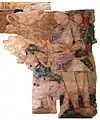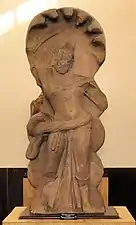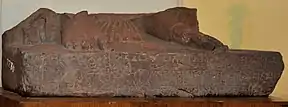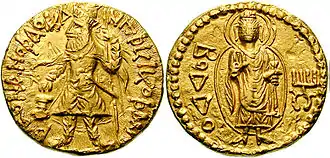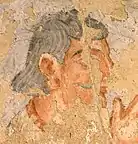Huvishka
Huvishka (Kushan: Οοηϸκι, "Ooishki", Brahmi: ![]()
![]()
![]() Hu-vi-ṣka)[3] was the emperor of the Kushan Empire from the death of Kanishka (assumed on the best evidence available to be in 150 CE) until the succession of Vasudeva I about thirty years later.
Hu-vi-ṣka)[3] was the emperor of the Kushan Empire from the death of Kanishka (assumed on the best evidence available to be in 150 CE) until the succession of Vasudeva I about thirty years later.
| Huvishka | |
|---|---|
| Kushan emperor | |
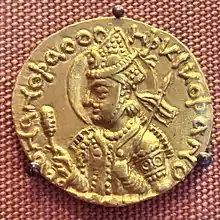 Coin of Huvishka. Legend in Kushan language and Greek script (with the Kushan letter Ϸ "sh"): ϷΑΟΝΑΝΟϷΑΟ ΟΟΗϷΚΙ ΚΟϷΑΝΟ ("Shaonanoshao Ooishki Koshano"): "King of kings, Huvishka the Kushan". | |
| Reign | 150–180 CE |
| Predecessor | Kanishka |
| Successor | Vasudeva I |
| Burial | |
| Dynasty | Kushan |

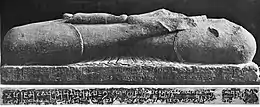
His rule was a period of consolidation for the Empire. Huvishka's territory encompassed Balkh in Bactria to Mathura in India, locations were it is known that he minted his coinage. His reign seems to have been essentially peaceful, consolidating Kushan power in northern India, and moving the center of the Kushan Empire to the southern capital city of Mathura.[4]
Religion
Huvishka was the son of Kanishka. His reign is also known as the golden age of Kushan rule. The reign of Huvishka corresponds to the first known epigraphic evidence of the Buddha Amitabha, on the bottom part of a 2nd-century statue which has been found in Govindo-Nagar, and now at the Mathura Museum. The statue is dated to "the 28th year of the reign of Huvishka", and dedicated to "Amitabha Buddha" by a family of merchants. There is also some evidence that Huvishka himself was a follower of Mahāyāna Buddhism. A Sanskrit manuscript fragment in the Schøyen Collection describes Huvishka as one who has "set forth in the Mahāyāna."[5]
Compared to his predecessor Kanishka, Huvishka was worshipper of Shiva.[6]
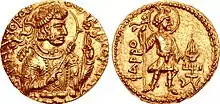
He also incorporates in his coins for the first and unique time in Kushan coinage the Hellenistic-Egyptian Serapis (under the name Σαραπο, "Sarapo"[7]), and the Goddess Roma (thought to represent "Roma aeterna"), under the name "Riom" (Greek: ΡΙΟΜ).[8]
Some of the coins of Huvishka also featured Maaseno on his coins, the Kushan incarnation of the Hindu god Karttikeya, or Skanda, whose epithet was "Mahasena". This god being particularly important to the Yaudheyas, it may have been incorporated into Kushan coinage when the Kushans expanded into Yaudheya territory in order to establish control of the Mathura area. It may also have been adopted as a way to appease the warlike Yaudheyas. In effect, the Kushans became the suzerains of the Yaudheyas in the area.[9][10]
Coinage and statuary
The coinage of Huvishka is characterized by a great variety of designs and the large quantity of gold coins that were minted: more gold coins from Huvishka are known than from all other Kushan rulers combined.[4] The location of his mints was mainly in Balkh and Peshawar, with smaller mints in Kashmir and Mathura.[4]
One of the great remaining puzzles of Huvishka's reign is the devaluation of his coinage. Early in his reign the copper coinage plunged in weight from a standard of 16g to about 10-11g. The quality and weight then continued to decline throughout the reign until at the start of the reign of Vasudeva the standard coin (a tetradrachm) weighed only 9g. The devaluation led to a massive production of imitations, and an economic demand for the older, pre-devaluation coins in the Gangetic valley. However, the motivation (and even some of the details) of this devaluation are still unknown.
|
|
References
| Kushan Empire 30 CE–350 CE | ||||||||||||||||||||||||||||||
|---|---|---|---|---|---|---|---|---|---|---|---|---|---|---|---|---|---|---|---|---|---|---|---|---|---|---|---|---|---|---|
|
||||||||||||||||||||||||||||||
- Marshak, Boris; Grenet, Frantz (2006). "Une peinture kouchane sur toile". Comptes rendus des séances de l'Académie des Inscriptions et Belles-Lettres. 150 (2): 257. doi:10.3406/crai.2006.87101.
- The inscription reads:
"In the year 33 of the Maharaja, the Devaputra Huvishka (












 Mahārājasya Devaputrasya Huviṣka) on the 8th day of the 1st summer (month), a Bodhisattva was set up at Madhuravanaka by the nun Dhanavati, the sister's daughter of the nun Buddhamitra, who knows the Tripitaka, a female pupil of the monk Bala, who knows the Tripitaka, together with her mother and father....". in Epigraphia Indica Vol 8. p. 182. Another similar inscription mentions "Huvihska in the year 26". in Sharma, R.C. (1994). The Splendour of Mathura Art and Museum. D. K. Printworld Pvt. Ltd. p. 142.
Mahārājasya Devaputrasya Huviṣka) on the 8th day of the 1st summer (month), a Bodhisattva was set up at Madhuravanaka by the nun Dhanavati, the sister's daughter of the nun Buddhamitra, who knows the Tripitaka, a female pupil of the monk Bala, who knows the Tripitaka, together with her mother and father....". in Epigraphia Indica Vol 8. p. 182. Another similar inscription mentions "Huvihska in the year 26". in Sharma, R.C. (1994). The Splendour of Mathura Art and Museum. D. K. Printworld Pvt. Ltd. p. 142. - Epigraphia Indica Vol 8. p. 182.
- Rezakhani, Khodadad (2017). From the Kushans to the Western Turks. p. 202.
- Neelis, Jason. Early Buddhist Transmission and Trade Networks. 2010. p. 141
- "RELIGIONS IN THE KUSHAN EMPIRE" (PDF). Archived from the original (PDF) on 14 March 2019.
Also omitted is the ancient Iranian war god Oˇrlagno, whose place and function are occupied by a group of Indian war gods, Skando (Old Indian Skanda), Komaro (Old Indian Kumara), Maaseno (Old Indian Mahascna), Bizago (Old Indian Vi ¯ s´akha), and even Ommo (Old Indian Um ¯ a), the consort of Siva. Their use as reverse types of Huvishka I is clear evidence for the new trends in religious policy of the Kushan king, which was possibly influenced by enlisting Indian warriors into the Kushan army during the campaign against Pataliputra.
- Serapis coin
- Mario Bussagli, "L'Art du Gandhara", 225
- Classical Numismatics Group
- Indian Sculpture: Circa 500 B.C.-A.D. 700, Los Angeles County Museum of Art, Pratapaditya Pal, University of California Press, 1986, p.78
- Marshak, Boris; Grenet, Frantz (2006). "Une peinture kouchane sur toile". Comptes rendus des séances de l'Académie des Inscriptions et Belles-Lettres. 150 (2): 947–963. doi:10.3406/crai.2006.87101. ISSN 0065-0536.
- Epigraphia Indica Vol 8. p. 180.
- Rhie, Marylin M. (2010). Early Buddhist Art of China and Central Asia, Volume 3: The Western Ch’in in Kansu in the Sixteen Kingdoms Period and Inter-relationships with the Buddhist Art of Gandh?ra. BRILL. p. xxxvii, Fig 6.17a. ISBN 978-90-04-18400-8.
- Schopen, Gregory (1987). "The Inscription on the Kuṣān Image of Amitābha and the Charakter of the Early Mahāyāna in India" (PDF). The Journal of the International Association of Buddhist Studies. 10 (2): 99–138.
Sources
- Bivar, A. D. H. (2004). "HUVIŠKA". Encyclopaedia Iranica, Vol. XII, Fasc. 6. pp. 583–585.CS1 maint: ref=harv (link)
| Wikimedia Commons has media related to Huvishka. |
External links
- Online Catalogue of Huvishka's Coinage
- Coins of Huvishka
- Was Huvishka sole king of the Kushan Empire
- The Devaluation of the Coinage of Kanishka
| Preceded by Kanishka |
Kushan Ruler 150–183 CE |
Succeeded by Vasudeva I |
- From the dated inscription on the Rukhana reliquary
- An Inscribed Silver Buddhist Reliquary of the Time of King Kharaosta and Prince Indravarman, Richard Salomon, Journal of the American Oriental Society, Vol. 116, No. 3 (Jul. - Sep., 1996), pp. 442
- A Kharosthī Reliquary Inscription of the Time of the Apraca Prince Visnuvarma, by Richard Salomon, South Asian Studies 11 1995, Pages 27-32, Published online: 09 Aug 2010
- Cribb, Joe; Donovan, Peter (2014). Kushan, Kushano-Sasanian, and Kidarite Coins A Catalogue of Coins From the American Numismatic Society by David Jongeward and Joe Cribb with Peter Donovan. p. 4.

